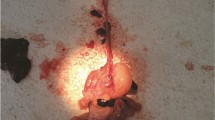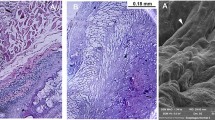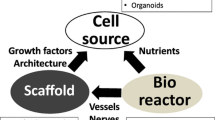Abstract
Recently, tissue engineering of the autologous esophagus has been thought to provide a promising strategy for esophageal substitution. In this study, gastric acellular matrix (GAM) was used as a scaffold for regeneration of the esophagus in a rat model. Usage of GAM has an advantage that naturally derived extracellular matrix autograft can be prepared less invasively in a clinical setting. Twenty-seven F344 female rats were used as recipients. Patch defects created in the abdominal esophagus were replaced by GAM patch grafts. The rats were sacrificed 1 week to 18 months after implantation. The specimen was examined macroscopically as well as microscopically. 5′-Bromo-2′-deoxyuridine (BrdU) proliferation assay was performed in six rats that were sacrificed 1, 2, and 4 weeks after implantation. Twenty-four rats survived without complications. The graft site did not show esophageal stenosis or dilatation in any rat. Keratinized stratified squamous esophageal mucosa was regenerated in the entire graft 2 weeks after implantation. Regeneration of the muscle layer or lamina muscularis mucosae in the graft site was not observed even 18 months after implantation. Marked incorporation of BrdU was observed only in the mucosal layer but not in the muscle layer. GAM patch graft provided satisfactory mucosal regeneration of the esophagus without stenosis or dilatation, although muscle regeneration was still a future challenge.





Similar content being viewed by others
References
Takimoto Y, Nakamura T, Yamamoto Y, Kiyotani T, Teramachi M, Shimizu Y (1998) The experimental replacement of a cervical esophageal segment with an artificial prosthesis with the use of collagen matrix and a silicone stent. J Thorac Cardiovasc Surg 116:98–106
Badylak S, Meurling S, Chen M, Spievack A, Simmons-Byrd A (2000) Resorbable bioscaffold for esophageal repair in a dog model. J Pediatr Surg 35:1097–1103
Lynen Jansen P, Klinge U, Anurov M, Titkova S, Mertens PR, Jansen M (2004) Surgical mesh as a scaffold for tissue regeneration in the esophagus. Eur Surg Res 36:104–111
Miki H, Ando N, Ozawa S, Sato M, Hayashi K, Kitajima M (1999) An artificial esophagus constructed of cultured human esophageal epithelial cells, fibroblasts, polyglycolic acid mesh, and collagen. ASAIO J 45:502–508
Grikscheit T, Ochoa ER, Srinivasan A, Gaissert H, Vacanti JP (2003) Tissue-engineered esophagus: experimental substitution by onlay patch or interposition. J Thorac Cardiovasc Surg 126:537–544
Parnigotto PP, Marzaro M, Artusi T, Perrino G, Conconi MT (2000) Short bowel syndrome: experimental approach to increase intestinal surface in rats by gastric homologous acellular matrix. J Pediatr Surg 35:1304–1308
Sutherland RS, Baskin LS, Hayward SW, Cunha GR (1996) Regeneration of bladder urothelium, smooth muscle, blood vessels and nerves into an acellular tissue matrix. J Urol 156:571–577
Hodde J (2000) Naturally occurring scaffolds for soft tissue repair and regeneration. Tissue Eng 8:295–308
Piechota HJ, Dahms SE, Nunes LS, Dahiya R, Lue TF, Tanagho EA (1998) In vitro functional properties of the rat bladder regenerated by the bladder acellular matrix graft. J Urol 159:1717–1724
Meezan E, Hjelle JT, Brendel K (1975) A simple, versatile, nondisruptive method for the isolation of morphologically and chemically pure basement membranes from several tissues. Life Sci 17:1721–1732
Komuro H, Nakamura T, Kaneko M, Nakanishi Y, Shimizu Y (2002) Application of collagen sponge scaffold to muscular defects of the esophagus: an experimental study in piglets. J Pediatr Surg 37:1409–1413
Acknowledgments
The authors thank Natsuko Kato for technical assistance. This work was supported by grant-in-aids for scientific research (no. 17390472) from the Japan Society for the Promotion of Science.
Author information
Authors and Affiliations
Corresponding author
Rights and permissions
About this article
Cite this article
Urita, Y., Komuro, H., Chen, G. et al. Regeneration of the esophagus using gastric acellular matrix: an experimental study in a rat model. Pediatr Surg Int 23, 21–26 (2007). https://doi.org/10.1007/s00383-006-1799-0
Published:
Issue Date:
DOI: https://doi.org/10.1007/s00383-006-1799-0




